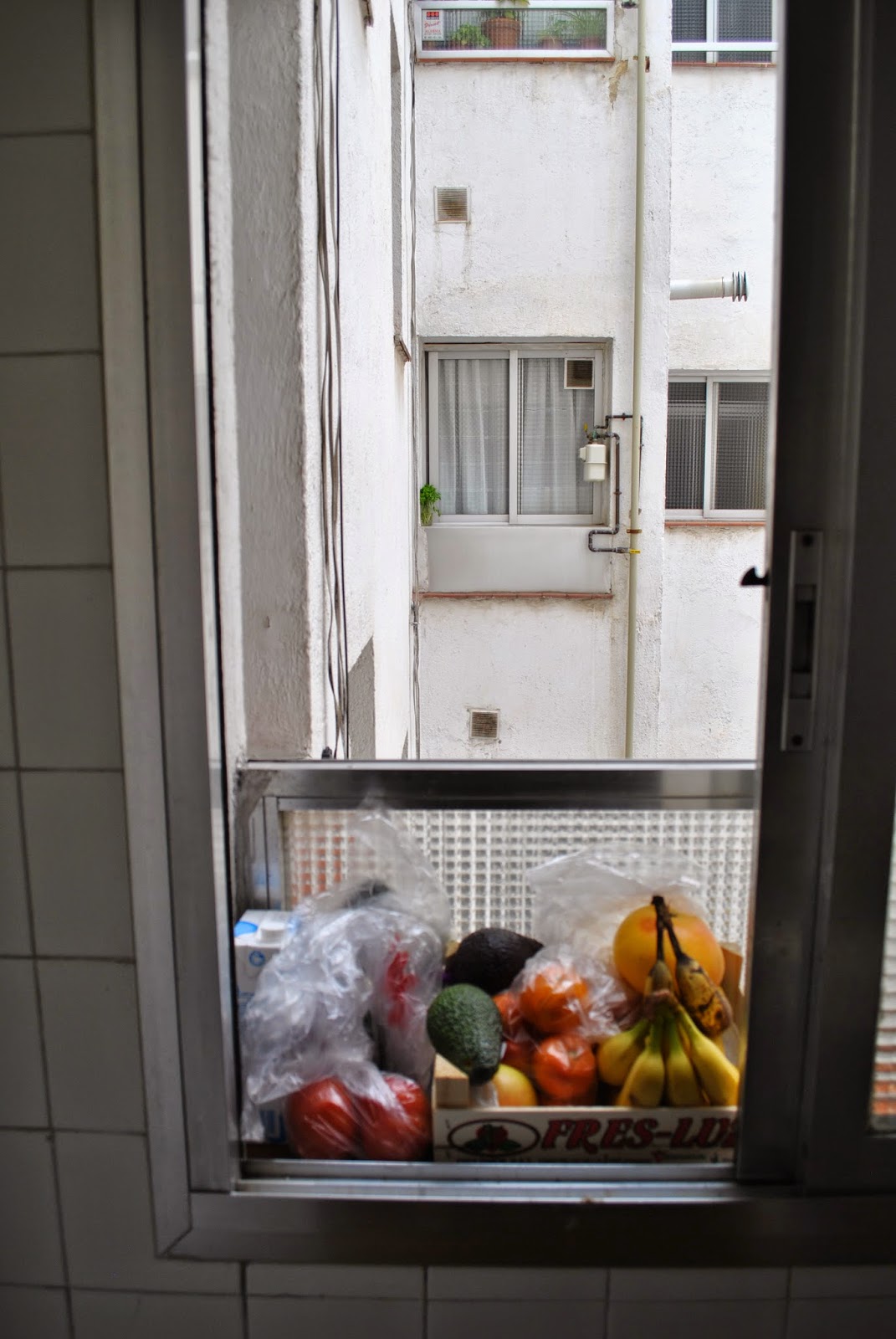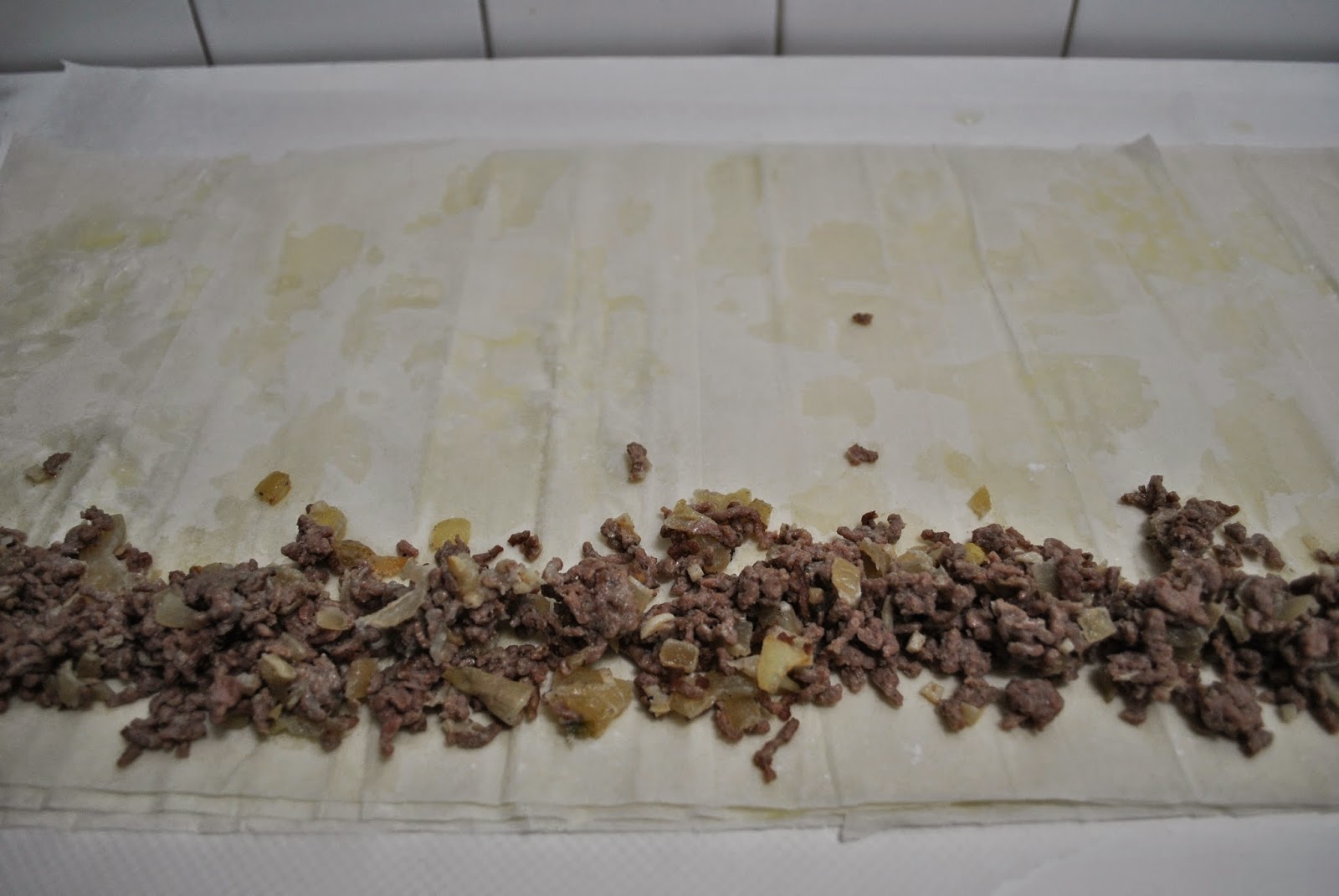In Bosnia they have three names for three types: 1) Bürek - made with ground meat; 2) Zeljanica - made with spinach, and called Spanikopita in Greece; and 3) Sirnica - made with white cheese. These three pies are called different things throughout the Balkans. Their origin is most likely Turkish - though like so many dishes the Greeks would certainly argue it originated with them. A very similar treat is made in Turkey, and it is also called bürek.
There are a two main ways you can make these pies: laying several sheets of filo in a pan, placing a layer of filling on top, and then sandwiching the filling with several more layers of filo; or laying many sheets of filo in a long skinny line several layers deep, placing a narrow line of filling near the long edge, and rolling the dough into a long snake. If using the second method, you can make the snake short and bake it in a U-shape, or make it very long and roll it into a round spiral. A third method, used in Turkey, is to make small "cigars". Using short strips of filo, you can make mini rolls and bake them. This is a great method for parties.
We always make ours in the form of a large spiral. Only if I am very lazy will I make it the first way, and I have yet to make it the Turkish way. I do hope to do this someday.
So, how do we make it?
The Filo Dough:
I usually buy my filo, because it is incredibly time consuming to make. There was only one occasion where I made it myself. It takes patience.
The dough is very simple: flour, salt, and water. The tricky thing is getting it thin enough before cooking. Anybody who has made homemade flour tortillas will know what I mean. Once the dough is made, roll it and stretch it until it is as thin as tissue paper. This is where practice and patience come in. Once it is thin enough, flop it down onto a large, slightly greased cookie sheet that is preheated in the oven. It will take no time to cook.
The Filling:
The below ingredients are for either a half or a whole pie. The pies I will make are both half pies.
Bürek:
- Ground Meat (200-400g/7-14oz) - Beef or lamb is more traditional, but you could use pork too.
- Onion (1/2 - 1 whole)
- Garlic (2-4 cloves)
- Cream (a couple spoonfuls to coat the meat when it is cooked) **Optional**
- salt and pepper to taste
Cook the meat in a small amount of oil. As it cooks, cut it into consistently small pieces. You do not want any large chunks.
Chop the onion and mince the garlic. You can also put the garlic through a garlic press. I, unfortunately, do not have one in Madrid.
Add the onion and garlic to the pan once the meat is done. Let it cook until the onion is golden.
Add cream (if you like) to the cooked and cooled filling.
Zeljanica/Spanikopita:
***I never make sirnica (cheese pie), but I always put feta in my spinach pie. This is not normal, but I think it is a wonderful combination. You can make pie with only spinach, but you will want to add a little salt.
- Spinach (200-400g/7-14oz)
- White Cheese/Plain Feta (100-200g/3.5-7oz)
Steam or boil the spinach just long enough for it to be soft. (In my case I used canónigos - lambs lettuce - because I could not get spinach at the local market)
Put the cooked spinach through a strainer or colander, and squeeze as much water out of the leaves as possible. You do not want it to be too wet, or the pie will not get crispy.
Dump the strained spinach onto a cutting board and chop it.
Add chopped feta to the spinach and mix it. You do not need to add salt, because the cheese is fairly salty by itself.
Preparing the Pies:
I will be making two spiraled half pies. Normally I would make two separate whole pies. If you are going to make a spiral formed pie, you will need a very large workspace. In our current home in Madrid, our kitchen is oppressively small. The counters in our house in Missoula are perfect for whole pies, but here it is only reasonable to make a half pie.
Two people can not even squeeze past each other in our kitchen, and there is so little space we are forced to keep fruits and vegetables on the ledge outside the window.
For putting the pies together, you will need a bowl with a mix of oil and water. Normally I would use a pastry brush for applying this mixture to the dough, but I do not have one here in Madrid. I will apply the mixture with a small spoon as well I can.
It is a delicate process to add the oil and water to the dough. You neither want the
dough to be too dry (it will crumble and split when rolled), nor too
wet (it will get sticky and fall apart).
Along a large, clean, and dry space, place the filo sheets in a long line with about 2 in (5cm) overlap.
Between each layer brush the sheets with the oil and water mixture. In my case I had three layers of filo, but four or five can make the pie even better.
Along the long edge of the layered filo sheets, place the meat filling evenly.
Roll the filo around the meat. It takes care to not break the dough; you must roll both ends evenly. If you are making a very long roll, a second pair of hands will improve the final outcome.
Finish the pie by rolling it into a spiral. If the dough was too dry (as it was for me), the roll will split.
Repeat the process for the spinach pie.
Baking the Pies:
Now that you have the pies formed, it is time to bake them. Normally, I place them snugly into circular cake pans, and I bake them until golden brown and crisp at 350F (175C). In the case of our tiny kitchen, we will not be doing so. Because Javi's aunt is paranoid about the gas in the oven, she has not hooked it up to the electricity. This is very frustrating for us, and we do not understand it.
There is no working oven in our kitchen, but there is a small electric pizza oven.
When we first moved into Javier's aunt's apartment, we were rather depressed that there was no oven, but we have made good use of this little pizza oven.
When you place the pies in the oven, brush again with the oil and water mixture. Do this one or two more times as they bake. This allows them to get golden and crisp, but not too dry.
They are baked!
So, what do we eat with these pies? We always prepare a salad to eat with them. A salad with a dressing of oil and vinegar, or yogurt and lemon juice is preferable.
Normally we have sour cream on the side, but since we are in Spain and sour cream is not easy to find (the closest substitute is crème fraîche, but it is expensive), we are going to make a tarator. In Bulgaria - where we first encountered tarator - this is made like a cold soup. It is made of yogurt, garlic, cucumber, and dill. In other parts of the former Ottoman Empire, it is made with walnuts or tahini, or served like a sauce. On hot days, it is a lovely soup. If you are prone to heartburn you might want to forgo the garlic, as it is raw.
Since we have no sour cream, we will make the tarator like a sauce. The difference is only whether you blend the ingredients or not. If you just mix them it is a lovely sauce. If you blend them the water in the cucumber makes it much thinner and is wonderful as a soup.
Tarator:
*** The quantities above are for soup for two.
- Plain yogurt (500g/18oz)
- Cucumber (1 large cucumber)
- Garlic (2 cloves)
- Dill (2 large spoonfuls minced)
- Salt and pepper to taste
Chop the cucumber and mince the garlic and dill.
Add the cucumber, garlic, and dill to the yogurt and mix. Add salt and pepper to taste. If you want it as a soup, blend it. The water in the cucumber will make it watery. If you want it as a sauce, cut the recipe in half or to one quarter - the quantities above are too much for a sauce.
Here it is!



























